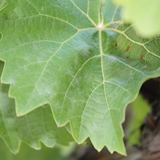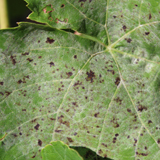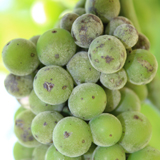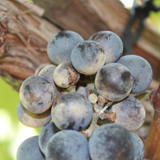Powdery Mildew of Grape Disease Prediction Model
Introduction to Powdery Mildew
Powdery mildew of grape is not a major problem of grape in the Midwest, but it can become a severe problem during dry weather. Uncinula necator favors warm conditions with high humidity, but not rainy weather. This is in contrast to other common diseases of grape, which require leaf wetness for infection and spore production.
Young tissue is most susceptible to infection, but any green plant part can become infected. Symptoms are easily recognized by the dusty white appearance of fungi growing in patches on surfaces of leaves, fruit, and vines.
Leaf infection
Young leaves can become stunted or distorted if infected (Figure 1). Fully expanded leaves may curl upward during hot weather. White powdery growth appearing on surfaces is masses of fungal spores (Figure 2). Black specs may develop on leaf surfaces late in the season as fruiting bodies are produced for preparation for overwintering. Infected vines have brown or black blotches on surfaces (Figure 3).
Fruit infection
Infected fruit develop patches of white fungal growth, similar to growth on leaves (Figure 4 & 5). They are often russetted, with rusty colored surfaces. Fruit may become misshapen or split. Red berries may fail to color properly when severely infected. Fruit is most susceptible from bloom until 3 to 4 weeks after bloom (veraison). Infected blossoms or cluster stems may brown and wither, dropping without setting fruit. If disease develops on cluster stems later in the season, berry drop may occur.
More information on grape powdery mildew can be found in publication PPFS-FR-T-12.
Spray recommendations for commercial growers
ID232
and homeowners
ID-21
are also available online.





Figure 1. Young leaves can become stunted or distorted if infected.
Figure 2. White powdery fungal growth appears on leaves; black fruiting bodies develop late in the season.
Figure 3. Infected vines have brown or black blotches on surfaces.
Figures 4 & 5. Patches of white powdery growth develop on fruit.
Notes
Risk for powdery mildew is highest in spring during leaf emergence and bloom, and again in fall after berry coloring, especially during cool rainy conditions.
Prediction model is based on leaf wetness duration and average temperature during wetness events
Instructions
• Select county from drop-down menu using arrows.
• Select today’s date to determine current risk for powdery mildew. Other dates may be entered if assessment of past risk is warranted.
• Determine vineyard history.
• Click 'submit choices'
These data are based on the 24 hour period 7PM to 7PM.
Data should NOT BE USED FOR LEGAL PURPOSES.